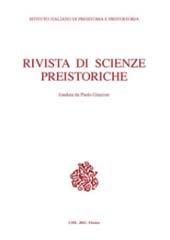Obsidian procurement and exploitation strategies during the Middle Neolithic B : two case studies from central-western Sardinia, Italy
P. 1-21
The aim of this study is to reconstruct the technological behaviours and obsidian acquisition strategies of the Middle Neolithic B communities settled in the proximity of obsidian sources in central-western Sardinia. This objective has been achieved by employing nondestructive techniques, including visual and instrumental analysis (PIXE and EDXRF), on selected assemblages from two contemporary contexts, Gribaia- Nurachi and Cuccuru Is Arrius 411-Cabras; these sites comprise multiple pits exhibiting distinctive features, filling, and unearthed materials. While such pits are commonly discovered in European archaeological sites, their precise function remains uncertain. In all the examined assemblages, obsidian from Monte Arci is by far the most common raw material exploited for chipped stone production, with the SC geochemical group being the most common.
In both contexts, reduction activities occurred in situ, as evidenced by the recurrence of cortical elements, debris and refitting pieces. The first stages of the chaîne(s) opératoire(s) are, therefore, always well represented, even if we have observed a lack of cores, which are commonly recovered exhausted.
A general impression of low technological investment gives off from these industries, mostly composed of flakes, that are systematically marked by a low standardization and a medium-small size. The achieved results provide insights on raw material selection and technological habits of the inhabitants of the analysed sites and, more generally, of coeval middle Neolithic Sardinian communities in the period of highest distribution of obsidian from the Monte Arci source. Furthermore, this research offers new interpretive hypotheses about the function of the deep negative structures in which our lithic remains were discovered. Indeed, the analysis of these assemblages, in conjunction with the available data on the techno-functional features of the associated pottery, has enabled us to postulate that the function of the pits may extend beyond the realm of ordinary daily activities. [Publisher's text]
L'obiettivo principale di questo lavoro è quello di ricostruire i comportamenti tecnici e le strategie di approvvigionamento messi in atto dalle comunità del Neolitico medio B, stanziate in prossimità delle fonti di approvvigionamento di ossidiana del Monte Arci. Per raggiungere questo scopo, sono stati analizzati i manufatti in pietra scheggiata provenienti da due contesti coevi, quello di Gribaia-Nurachi e quello di Cuccuru Is Arrius 411-Cabras, localizzati nella Sardegna centro-occidentale. I reperti in oggetto sono stati rinvenuti all'interno di fosse, strutture in negativo, differenti tra loro per forma, dimensione, tipologia e modalità di riempimento; evidenze di questo tipo sono piuttosto comuni nelle regioni continentali, ciononostante non è stato ancora possibile interpretarne univocamente la funzione: arrivare a proporre un'ipotesi in questo senso è il secondo obiettivo di questo studio.
Sugli elementi litici delle serie selezionate sono state eseguite, utilizzando un approccio non distruttivo, delle analisi di caratterizzazione visuali e strumentali (PIXE and EDXRF), che hanno consentito di riconoscere nell'ossidiana del Monte Arci e, più specificamente quella della varietà geochimica SC, la materia prima più frequentemente impiegata nei siti indagati. In entrambi i contesti le attività di riduzione sono avvenute sul posto, come dimostra la ricorrenza di pezzi corticati, raccordi, rimontaggi e debris.
Le prime fasi della chaîne(s) opératoire(s) sono sempre ben rappresentate, anche se i nuclei sono in numero ridotto; abbondano le schegge di dimensioni medio-piccole e poco standardizzate, che paiono il risultato di un investimento tecnico piuttosto basso. In conclusione, i dati raccolti in questo lavoro hanno fornito nuove informazioni circa le strategie di acquisizione e trasformazione dell'ossidiana durante un periodo cruciale quale il Neolitico medio B, quando l'ossidiana del Monte Arci inizia a essere distribuita su larga scala, in maniera massiva; tali dati hanno altresì consentito, unitamente a quelli derivanti dallo studio tecno-funzionale dei reperti ceramici rinvenuti in associazione a quelli litici, di proporre delle ipotesi interpretative circa la destinazione d'uso delle fosse presso le quali i reperti sono stati rinvenuti, che non sempre appare legata ad attività ordinarie. [Testo dell'editore]
Ist Teil von
Rivista di scienze preistoriche : LXXIV, 2024-
Artikel aus derselben Ausgabe (einzeln erhältlich)
-
Informationen
DOI: 10.32097/1223
ISSN: 2282-457X
KEYWORDS
- Obsidian, Monte Arci, Characterization, Middle Neolithic B.
- Ossidiana, Monte Arci, Caratterizzazione, Neolitico Medio B.


